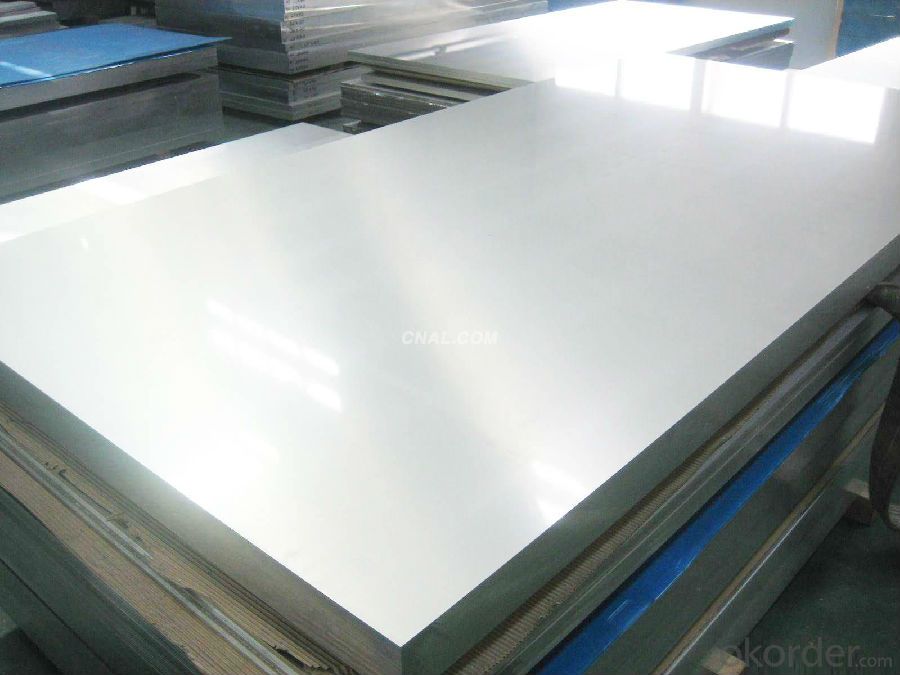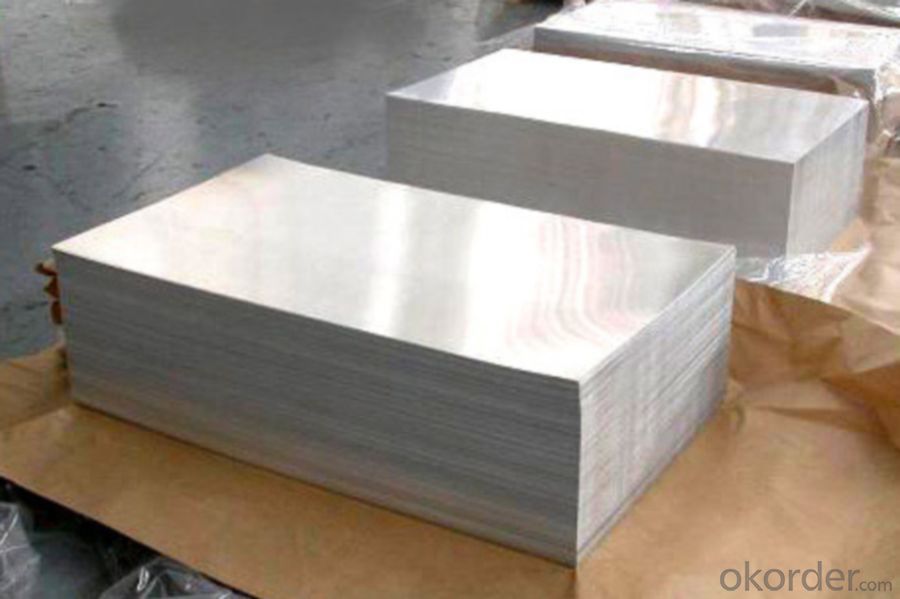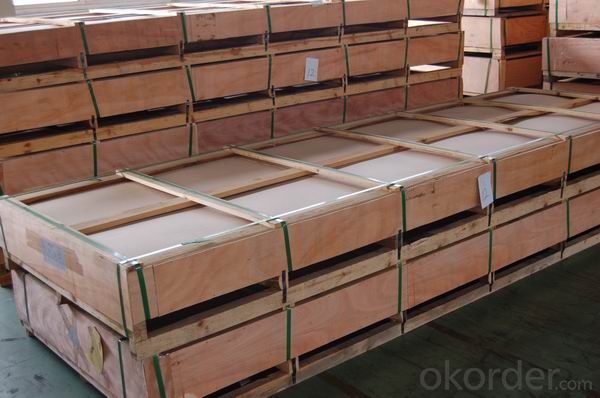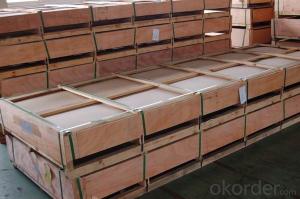Aluminum Sheets AA5083 Used for Construction
- Loading Port:
- Shanghai
- Payment Terms:
- TT OR LC
- Min Order Qty:
- 8 m.t.
- Supply Capability:
- 10000 m.t./month
OKorder Service Pledge
OKorder Financial Service
You Might Also Like
1.Structure of Aluminum Sheets AA5083 Used for Construction Description
Aluminum Sheets AA5083 Used aluminum curtain wall base plate, the traffic sign ,air-conditioner heat and exchangers. It is very popular on the market with competitive prices.
Aluminum Sheets AA5083 have been widely used in the fields of construction and decoration, electronic applications, lighting decoration, air-condition air pipes, sandwich panels and drainages etc. Resistant to weather corrosion ,durability, formability, self Cleansing
2.Main Features of Aluminum Sheets AA5083 Used for Construction
• Excellent weather-proof durability
• High erosion resistance
• Good mechanical processing performance
• High flexibility
3.Aluminum Sheets AA5083 Used for Construction Images



4.Aluminum Sheets AA5083 Used for Construction Specification
Alloy | AA5083 |
Temper | H14, H16,O/F |
Thickness | 0.2mm -- 100mm |
Width | 30mm -- 1700mm |
Standard | GB/T 3880-2006 |
5. FAQ of Aluminum Sheets AA5083 Used for Construction
A.Where is your facotry?
Our mill is in Henan Province. It is about three hours by high-speed train.
B.When will you deliver the products?
Aluminum Sheets AA5083 Used for Construction will be delivered within about 30 to 35 days after receiving advanced payment or original L/C.
- Q:Can aluminum sheet be used for automotive heat shields?
- Indeed, aluminum sheet is a suitable option when it comes to automotive heat shields. The automotive industry favors aluminum due to its impressive thermal conductivity and remarkable heat resistance. By reflecting and dispersing heat away from specific regions, it effectively safeguards delicate components from excessive temperatures. Moreover, aluminum possesses the advantages of being lightweight and resistant to corrosion, rendering it an optimal choice for automotive purposes. It finds widespread utilization in diverse heat shield configurations, encompassing exhaust, engine, and under-carriage heat shields.
- Q:Can aluminum sheets be used for HVAC systems?
- Yes, aluminum sheets can be used for HVAC systems. Aluminum is a popular material choice for HVAC applications due to its many advantageous properties. It is lightweight, making it easier to handle and install. Aluminum is also highly resistant to corrosion, which is crucial for HVAC systems that are exposed to moisture and varying temperatures. Additionally, aluminum has excellent thermal conductivity, allowing for efficient heat transfer. This makes it ideal for heat exchangers and other components in HVAC systems. Overall, aluminum sheets are a reliable and durable option for HVAC systems.
- Q:Where does China make aluminum plate?
- In many parts of the country have aluminum factory, the old state-owned enterprises have 101, SWA aluminum plant, located in the southwest, northeast china. The emerging aluminum processing base in Henan, due to resource advantages, the largest aluminum factory, the price is relatively low.
- Q:Where is the difference between the 5052 aluminum plate and the 1060 Aluminum plate?
- Composition and properties are not the same, first of all, 5052 belong to the alloy (aluminum magnesium) aluminum, aluminum content of about 95%, the magnesium content of about 4%, there are some other trace metals, 1060 pure aluminum (aluminum content of 99.6%, the balance of other metal elements); followed by mechanical propertiesTwo aluminum in the same state, 5052 to 1060 in hardness, elongation, tensile strength and so on are not the same. Specific depends on what state (H14, H32, H24, O state, etc.); finally, because the price of different components determine the price is different, the price is usually 5052 higher than 1060.
- Q:How do aluminum sheets perform in terms of weather resistance?
- Aluminum sheets possess remarkable properties when it comes to resisting weather. Their innate ability to resist corrosion enables them to endure exposure to various weather conditions without deteriorating or rusting, making them highly suitable for outdoor uses. The natural formation of a protective oxide layer on the surface of aluminum acts as a barrier against moisture, preventing the metal from reacting with oxygen and thereby reducing the risk of corrosion. Moreover, aluminum sheets exhibit a high resistance to UV radiation, which means they can withstand prolonged exposure to the sun without fading or discoloration. In conclusion, aluminum sheets exhibit outstanding weather resistance and are a dependable choice for a wide range of outdoor applications, such as roofing, siding, and outdoor signage.
- Q:iron-based alloys over aluminum in structural members of bridges and buildings?
- Aluminum is chosen in aerospace because it is light weight. Iron is preferred in structures here on earth because of its strength and suitability to endure gravity for a long period of time.
- Q:How do aluminum sheets handle extreme temperatures?
- The exceptional ability of aluminum sheets to handle extreme temperatures is widely recognized. This is primarily due to their high thermal conductivity, which enables them to effectively dissipate heat. As a result, they are suitable for applications involving high temperatures. Aluminum, with a melting point of 660 degrees Celsius (1220 degrees Fahrenheit), can withstand a wide range of extreme temperatures without compromising its structural integrity. When exposed to intense heat, aluminum sheets do not easily deform or warp. Consequently, they are ideal for use in environments with high temperatures, such as industrial furnaces, automotive engines, and aerospace applications. Furthermore, aluminum has a low coefficient of thermal expansion, meaning it expands and contracts minimally when subjected to temperature variations. This significantly reduces the risk of cracking or structural damage. On the contrary, aluminum also performs exceptionally well in extremely cold temperatures. It remains durable and retains its strength even in freezing conditions. This makes aluminum sheets suitable for cryogenic applications, including the construction of liquid natural gas tanks or aerospace components that operate in low-temperature environments. In conclusion, aluminum sheets excel in handling extreme temperatures due to their high thermal conductivity, low coefficient of thermal expansion, and excellent structural integrity. Whether subjected to intense heat or extreme cold, aluminum sheets remain stable and reliable, making them the preferred choice in various industries.
- Q:What are the different manufacturing methods for aluminum sheets?
- There are several different manufacturing methods for aluminum sheets, each with its own unique characteristics and applications. 1. Rolling: The most common method of manufacturing aluminum sheets is through rolling. In this process, large slabs of aluminum are passed through a series of rollers, which reduce the thickness of the slab and increase its length. This method can produce sheets with consistent thickness and excellent surface finish. 2. Extrusion: Extrusion is another method used to manufacture aluminum sheets. In this process, a heated billet of aluminum is forced through a die, resulting in a continuous length of sheet. Extrusion allows for complex shapes and profiles to be created, making it suitable for applications such as building construction and automotive components. 3. Casting: Casting involves pouring molten aluminum into a mold and allowing it to cool and solidify into a sheet shape. This method is often used for producing thicker sheets or sheets with specific alloy compositions. Casting can offer unique properties and is commonly used in industries such as aerospace and defense. 4. Cladding: Cladding is a process where a thin layer of aluminum is bonded to another material, such as steel or composite materials. This method combines the desirable properties of aluminum, such as corrosion resistance and lightweight, with the strength and durability of the base material. Clad aluminum sheets are commonly used in construction, transportation, and electrical industries. 5. Powder metallurgy: Powder metallurgy involves the formation of aluminum sheets from powdered aluminum particles. The powder is compacted into a desired shape and then sintered at high temperatures to fuse the particles together. This method is used for producing complex shapes and can provide improved mechanical properties. Each manufacturing method for aluminum sheets has its own advantages and disadvantages, depending on the desired properties, application, and cost considerations. Therefore, it is important to carefully select the most appropriate method based on the specific requirements of the project.
- Q:Are aluminum sheets suitable for architectural canopies?
- Architectural canopies can indeed be made using aluminum sheets. Aluminum is a popular material choice for architectural applications because of its lightweight nature, durability, and flexibility. It possesses a high strength-to-weight ratio, making it capable of enduring various weather conditions and providing stability for canopies. Moreover, aluminum is highly resistant to corrosion, ensuring that the architectural canopy remains visually appealing and functional for an extended period. Its malleability allows for easy fabrication and customization, enabling architects and designers to create unique and intricate canopy designs. Additionally, aluminum is an environmentally friendly option as it can be recycled, contributing to sustainable construction practices. All in all, aluminum sheets are a dependable and versatile choice for architectural canopies.
- Q:Can aluminum be either conductive or magnitized?
- Aluminium saucepans and frypans demonstrate that Al conducts heat, aluminium wires are used because it is a very good conductor of electricity, but lighter and cheaper than copper, so used on overhead cables. Most lay-people would describe Al as non-magnetic. However, Al is weakly paramagnetic. It does not hold a magnetic field, but does respond to a (strong) magnetic field, albeit weakly. The effect is strongest at low temperatures, and decreases as temp increases.
1. Manufacturer Overview |
|
|---|---|
| Location | |
| Year Established | |
| Annual Output Value | |
| Main Markets | |
| Company Certifications | |
2. Manufacturer Certificates |
|
|---|---|
| a) Certification Name | |
| Range | |
| Reference | |
| Validity Period | |
3. Manufacturer Capability |
|
|---|---|
| a)Trade Capacity | |
| Nearest Port | |
| Export Percentage | |
| No.of Employees in Trade Department | |
| Language Spoken: | |
| b)Factory Information | |
| Factory Size: | |
| No. of Production Lines | |
| Contract Manufacturing | |
| Product Price Range | |
Send your message to us
Aluminum Sheets AA5083 Used for Construction
- Loading Port:
- Shanghai
- Payment Terms:
- TT OR LC
- Min Order Qty:
- 8 m.t.
- Supply Capability:
- 10000 m.t./month
OKorder Service Pledge
OKorder Financial Service
Similar products
New products
Hot products
Related keywords






























